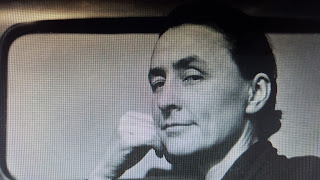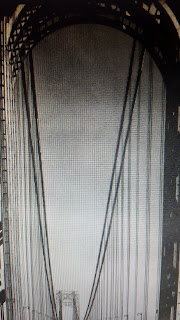In a small room halfway round Tate Modern's The Radical Eye:Modernist Photography From The Sir Elton John Collection (in the Switch House, now rechristened the Blavatnik Building) Elton explains how, on sobering up in 1990, photography became his new obsession, or one of his new obsessions. From knowing next to nothing about it to buying a larger house in Atlanta than he needed just to store his growing collection Elton has, somewhat predictably, bought a lot of photography. He might've spent more on photos than flowers.
At least he has impeccable taste. The selection on loan to the Tate all date from the first half of the last century but range from portraiture and landscapes to abstractions and other experimental work. As you might expect there's a keen appreciation of the male form - but also an equally prurient eye glances over the female body too. I visited with my friend Owen over Xmas and then again this weekend and it was a pleasure both times.
Artists like Laszlo Moholy-Nagy and Man Ray (who's all over this show) sought to find out what the camera could see that the human eye couldn't. Moholy-Nagy went as far as to suggest that photography could radically change not just what we see but how we see. He called it the 'new vision' and felt photography shouldn't simply aim to emulate other art forms but strike out on its own, a bold new form in its own right. Man Ray's Rayograph and the Dutch born vegetarian horticulturalist Johan Hagemeyer came good on Moholy-Nagy's promises. Man Ray may ape Soviet constructivist styles but the lumonisty in his work could only have come from manipulation of light, chemicals, and paper.
Hagemeyer, like Frantisek Drtikol and Imogen Cunningham, finds beauty in the stolen moment, the everyday. Shadows, oil tanks, statues standing alone forsaken like clipped elements of de Chirico's metaphysical landscape paintings. Considering some of this stuff is nearly a century old it's alarmingly modern.
Laszlo Moholy-Nagy - View from the Berlin Radio Tower (1928)
Man Ray - Rayograph (1923)
Imogen Cunningham - Oil Tanks (1940)
Frantisek Drtikol - Old Prague (1912)
Johan Hagemeyer - Untitled (Power Lines), San Francisco (1928)
Man Ray's portraiture wasn't quite so brave as his rayograph work but in capturing Picasso, Matisse, Dora Maar, Satie, Brancusi, Breton, Derain, Tanguy, and, of course, himself he managed to document many of the great and the good of the Paris art world he inhabited. Hagemeyer couldn't help but make a detail of Dali's exuerbant showmanship, Stieglitz's portrait of his lover Georgia O'Keeffee captures something of their complicated relationship, Edward Weston (whose photograph of his lover Tina Modotti is matched with her's of his - how romantic) looks Stravinsky straight in the eye, and James Van Der Zee does something none of the rest of them bother to. He gets off his arse and heads down to Harlem to meet people who aren't famous. As a leading figure in the Harlem Renaissance his work does wonders in opening a window on to the rebirth of the African-American arts scene in the 1920s.
Duke Ellington would've been playing in New York City to both those crowds and the uptown ones during that decade so it seems incongruous perhaps that Irving Penn's portrait of one of the most important musicians of the last century sees him confined in a tight corner. Perhaps he was trying to show that Ellington was always striving to break out from constrictions, be they racial or musical. These portraits are psychological as much as they're physical.
Man Ray - Pablo Picasso (1922)
Johan Hagemeyer - Salvador Dali (1944)
Alfred Stieglitz - Georgia O'Keeffe (1922)
Edward Weston - Igor Stravinsky (1935)
James Van Der Zee - Portrait, Harlem (1934)
Irving Penn - Duke Ellington, New York (1948)
Dora Maar wasn't just a 'muse' (thank goodness) but an artist in her own right. She was as happy to objectify the male figure as Picasso was hers. You only need look at her eroticised rendering of Alberto Spaolini. George Platt Lynes made the most of Art Deco flourishes in his homoerotic fashion photography while the Viennese Rudolf Koppitz and Czech Drtrikol were more content artfully rendering naked female bodies. Yet Edward Steichen's lace clad Gloria Swanson is the sexiest of them all. The Sunset Boulevard star manages to look demure, alluring, and a bit terrifying at the same time.
Dora Maar - The Dancer Alberto Spaolini (1935)
Rudolf Koppitz - Movement Study (1925)
Frantisek Drtikol - Untitled (Nude with Wave Construction) (1925)
George Platt Lymes - A Forgotten Model (1937)
Edward Steichen - Gloria Swanson, New York (1924)
Portraiture and experimentation were far from separate areas of practice. Photographers were harnessing techniques that may have previously been considered 'mistakes'. Distortion and scratching for example. Curved lenses were used. Patterned glass too. Some went as far as to melt the negative to achieve their desired effect.
It would appear that Max Ernst was an artist only too happy to pose for these modern, often unflattering, portraits. Man Ray's 1938 photo of him looks like it could be an advert for a spy film. It seems to belong at least three decades later.
Man Ray - Glass Tears (1932)
Man Ray - Max Ernst (1938)
Frederick Sommer - Max Ernst (1938)
German Surrealist Josef Breitenbach pushed the envelope back even further with a cut up technique still being aped, often with inferior results, today, Weston's nude has the sinuous form of a Matisse, and Ferenc Csik's divers celebrated human athleticism in a way that has worrying overtones of the Aryan suprematism being expounded by the Nazis not far from Csik's native Hungary at the same time.
Josef Breitenbach - Forever and Ever, Paris (1938)
Edward Weston - Nude (1936)
Ferenc Csik - Diver (1936)
Europe was troubled and America was too. As John Steinbeck wrote about the Great Depression and the dustbowl, and Woody Guthrie sang about it, Walker Evans and Dorothea Lange, most famously of all, froze the images of those who lived it into our mind for eternity. Lange's Migrant Mother is one of the most celebrated of all photographs and its power remains undimmed yet The Damage Is Already Done, from the same year, is perhaps more powerful still. An innocent face corrupted, possibly beyond repair, by the degradation she's seen and been subjected to. This is documentary photography at its very best.
Walker Evans - Bud Fields, Alabama Tenant Farmer (1936)
Dorothea Lange - Migrant Mother (1936)
Dorothea Lange - The Damage is Already Done, Shacktown, Elm Grove, Oklahoma (1936)
Elsewhere in the US Helen Levitt took snapshots of everyday life in the Big Apple and Evans did the same for the Big Easy. The torn Greta Garbo poster that Ilse Bing saw in Paris predates Mimmo Rotella's psychogeographical decollages by twenty or so years. All these works must've looked amazing when they were first made but history has added a depth to them that possibly the artists themselves could not've been aware of (though the child in Levitt's 1939 New York doesn't look so different to children these days, and why should she?).
Helen Levitt - New York (1939)
Ilse Bing - Greta Garbo Poster, Paris (1932)
Walker Evans - New Orleans, Louisiana (Street Corner) (1936)
The final room is cumbersomely titled 'Objects, Perspectives, Abstractions' and it doubles down on some of the themes that the previous rooms have nodded towards. Edward Weston must be second only to Man Ray in Elton's collection and I will confess a preference for his artfully shadowed church door over his painfully engorged phallic gourd.
Kertesz's distorted clocks belong in Surrealism, Bourke-White's George Washington Bridge and Toni Schneider's Rail Spider mine psychogeographical landscape territory further, and Herbert List seems to be celebrating the lives of the nouveau riche. Photography, now a fully grown up art form, was pushing out in all directions and the harder it was to get to grips with where it was heading the more interesting that journey became.
Edward Weston - Gourd (1927)
Edward Weston - Church Door - Hornitos (1940)
Dorothy Norman - Rockerfeller Center Church IX (1930s)
Andre Kertesz - Clock Distortion (1938)
Herbert List - Lake Lucerne, Switzerland (1938)
Toni Schneiders - Rail Spider, Hamburg-Altona (1950)
Margaret Bourke-White - George Washington Bridge (1933)
Alexsandr Rodchenko/Varvara Stepanova - Be Ready (1934)
Rodchenko and Stepanova's Be Ready is the only work in the show to contain any colour. It sits uneasily amongst the others yet you can see why Elton felt he needed this masterpiece of Russian modernism in his collection. It's quite beautiful.
As the bankers wander silently across New York, as a solitary figure hovers at the bottom of a Pennsylvania staircase, and as Imogen Cunningham's gas tanks once again loom large over us small, seemingly insignificant human beings, photography is revealed to be, at heart, a lonely pastime that catches people, or even buildings, in often unguarded moments. It aims to say something about us, about our souls, and occasionally it succeedss. Other times the mirror we look into returns a stare as blank as Man Ray's Ostrich Egg. We think we know others. We think we know ourselves. Photography reveals just how much we really do - and just how much we really don't.
I'm jealous of Elton John having this collection in his house, or one of his houses, and I'm glad he shared it. I also thank Owen for taking me along to this the first time. It was, as ever, an education.
Paul Strand - Wall Street, New York (1915)
Lloyd Ullberg - Philadelphia (1935)
Imogen Cunningham - Gas Tanks (1927)
Man Ray - Ostrich Egg (1944)











































No comments:
Post a Comment